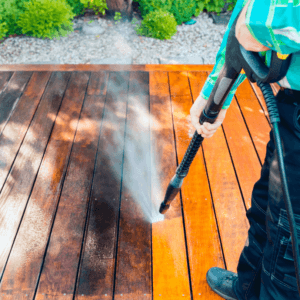Pressure Washing Solutions for Mould Remediation
Pressure Washing Solutions for Mould Remediation
Summary
This article discusses the importance of pressure-washing solutions for mould remediation. It emphasises the detrimental effects of mould on properties and health. The article highlights the key steps involved in pressure washing, such as surface preparation, high-pressure cleaning, and chemical additives. It also outlines the advantages of pressure washing, including comprehensive cleaning, environmental friendliness, time efficiency, and its role as a preventative measure. The article stresses the importance of professional expertise in mould remediation.
When dealing with the persistent problem of mould remediation, it’s crucial to have effective solutions in place. Mould can not only damage your property but also pose health risks to those who frequent it. This article aims to provide you with comprehensive insights into pressure-washing solutions for mould remediation.
Understanding the Mould Issue
Mould, a type of fungus, thrives in damp and humid environments, often going unnoticed until it becomes a significant problem requiring mould remediation. Not only does mould damage surfaces, but it can also release harmful spores into the air, leading to various health problems, including allergies and respiratory issues. Additionally, mould infestations can negatively impact your property’s aesthetic appeal and overall indoor air quality.
The Power of Pressure Washing
Pressure washing stands out as a highly effective mould remediation method for a variety of surfaces, such as walls, sidewalks, and even roofs. This method involves the use of a high-pressure stream of water to dislodge and wash away mould, dirt, and other contaminants. Let’s delve into how pressure washing can contribute to mould remediation:
Surface Preparation
Before embarking on the pressure washing process, proper surface preparation is critical. This includes removing loose debris and applying a specialised cleaning solution to target mould and mildew. Adequate preparation ensures that pressure washing is more efficient in eliminating mould.
High-Pressure Cleaning
The core of pressure washing lies in the forceful water jet it produces. This jet effectively dislodges mould from the surface, ensuring a thorough cleaning. It can reach into crevices and challenging-to-access areas where mould tends to hide.
Chemical Additives
In some instances, the use of chemical additives in conjunction with pressure washing can enhance mould remediation. These additives can aid in breaking down the mould and preventing its re-growth. Professionals can recommend the appropriate chemicals based on your specific situation.
Advantages of Pressure Washing for Mould Remediation
Pressure washing offers numerous advantages when it comes to dealing with mould issues on your property:
Comprehensive Cleaning
Pressure washing provides a thorough and all-encompassing cleaning process. It doesn’t just remove surface mould but penetrates deep into affected areas, ensuring that no spores are left behind.
Environmentally Friendly
Pressure washing is an environmentally friendly solution. It primarily uses water and, when necessary, biodegradable cleaning agents, making it a sustainable choice for mould remediation.
Time-Efficient
Compared to manual scrubbing or other cleaning methods, pressure washing is highly time-efficient. It can cover large areas in a relatively short period, minimising disruption to your daily operations.
Preventative Measure
Regular pressure washing not only eliminates existing mould but also acts as a preventative measure. By keeping surfaces clean and mould-free, you can reduce the chances of future infestations.
Professional Expertise
While pressure washing can be an effective method for mould remediation, it’s essential to approach it with care. Improper use of high-pressure equipment can damage surfaces or even pose safety hazards. This is where professional expertise becomes invaluable.
Experts in mould remediation understand the intricacies of different surfaces and mould types, enabling them to provide tailored solutions for your property. They prioritise safety and efficiency, ensuring that your premises are mould-free without any adverse consequences.
Mould remediation is a critical aspect of maintaining a healthy and safe environment, whether it’s a commercial or residential property. Pressure washing serves as a powerful solution for efficiently and effectively dealing with mould infestations. Don’t let mould compromise your property’s condition and the well-being of its occupants.
FAQs
What causes mould growth in buildings?
Mould growth in buildings is primarily caused by excess moisture. When there is water intrusion from leaks, high humidity levels, or inadequate ventilation, it creates an ideal environment for mould to thrive. Mould spores are naturally present in the air, and when they find moisture and organic materials (such as drywall or wood), they can start to grow and multiply.
How can I tell if I have a mould problem in my home or business?
There are several signs that can indicate a mould problem. These include:
- Visible mould growth on surfaces, often appearing as black, green, or brown spots.
- A musty or earthy odour is a common indicator of hidden mould growth.
- Water stains or discoloured patches on walls or ceilings.
- Increased allergies or respiratory issues among occupants.
- Peeling paint or wallpaper can result from moisture damage.
Can I remove the mould myself, or do I need professional mould remediation services?
Small, isolated patches of mould on non-porous surfaces (like bathroom tiles) can often be cleaned by property owners using appropriate cleaning agents and protective gear. However, for extensive mould growth or mould in porous materials like drywall, it’s recommended to seek professional mould remediation services.
Why Choose AllAces?
AllAces Cleaning & Restoration has more than 35 years of industry experience, handling mould remediation projects for both domestic and commercial clients. Our IICRC-certified technicians utilise the latest technology and equipment to ensure the best results.



